
There was an increase in the number and length of mental health evaluations at a California emergency room after a nearby treatment center cut back on services, according to a new study.
"Unfortunately, resources to help these vulnerable patients are frequently the target of funding cuts," said lead author Dr. Arica Nesper, who worked on the research while at the University of California, Davis. "We aimed to describe this effect on our emergency department and the care provided to our patients."
The researchers decided to conduct the study after noticing more patients were coming into their ER with mental health needs after the adjacent county mental health treatment center downsized, Nesper told Reuters Health by email.
Specifically, the center cut the number of its inpatient beds in half and eliminated its outpatient services in October 2009.
Community mental health centers can provide a wide range of services including assessment, crisis stabilization, behavioral therapy and medication. They may even provide non-medical needs like helping patients find housing or other forms of support.
The study team reviewed nearly 64,000 patient visits to the UC Davis emergency department to analyze the number, type and duration of psychiatric visits from October 2008 through May 2009 and October 2009 through May 2010.
During the study periods, 1,392 ER visits required a psychiatric evaluation. Overall, psychiatric evaluations increased from about one per day before the treatment center cut its services to about four per day afterward.
The average length of stay for patients undergoing psychiatric evaluations also increased from about 14 hours to around 22 hours, the researchers write in the Annals of Emergency Medicine.
There were increases in most of the types of problems people brought to the ER, including being assaultive or suicidal. Fewer people were referred to a psychiatric hospital and more were sent home after the treatment center cut its services.
Before the decrease in county mental health services, patients would have been able to go to an intake facility and stay there if they needed to be hospitalized, said Nesper, who is now at the Stanford University Medical Center, also in California.
"Our study suggests that when these resources became unavailable, these patients came to our emergency department, as they had nowhere else to go," she said.
Because the study was observational, it is possible that other factors such as rising unemployment rates could have contributed to the changes seen in the ER, said Ellen Meara, of The Dartmouth Institute for Health Policy and Clinical Practice.
Meara, who was not involved in the study, does feel that reducing treatment services can have wide-ranging consequences.
"Cutting community resources to treat patients with severe mental illness is a common response to tight local budgets, but it may increase problems in other parts of the healthcare system, and the broader community," she said.
Meara added that lack of adequate mental healthcare can also increase hospital visits for other medical reasons, because patients with severe mental illness tend to have more trouble managing medical conditions such as diabetes.
"Readers should understand the importance of high quality and readily available mental health services in our communities," Nesper said. "A lack of available mental health resources has a profound impact on clinicians and staff working in the emergency department as well as patients."
Meara advises policymakers to consider the negative impact for patients and the hospitals affected when considering cuts in local budgets for community-based treatment of severe mental illness.